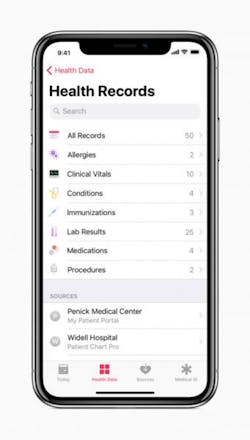In breaking digital health news today, Apple has announced that it is launching a feature that will allow consumers to see their medical records right on their iPhone.
In a Jan. 24 announcement Apple said, “The updated Health Records section within the Health app brings together hospitals, clinics and the existing Health app to make it easy for consumers to see their available medical data from multiple providers whenever they choose. Johns Hopkins Medicine, Cedars-Sinai, Penn Medicine and other participating hospitals and clinics are among the first to make this beta feature available to their patients.”
Indeed, Apple is testing this feature out with 12 hospitals in all, inclusive of some of the most prominent healthcare institutions in the U.S. The tech giant said it has “worked with the healthcare community to take a consumer-friendly approach, creating Health Records based on FHIR (Fast Healthcare Interoperability Resources), a standard for transferring electronic medical records.”
Now, consumers will have medical information from various institutions organized into one view covering allergies, conditions, immunizations, lab results, medications, procedures and vitals, and will receive notifications when their data is updated. Health Records data is encrypted and protected with the user’s iPhone passcode, the company stated.
Jeff Williams, Apple’s COO, said in a statement on Jan. 24, “Our goal is to help consumers live a better day. We’ve worked closely with the health community to create an experience everyone has wanted for years — to view medical records easily and securely right on your iPhone. He added, “By empowering customers to see their overall health, we hope to help consumers better understand their health and help them lead healthier lives.”
A look at Apple's "Health Records" feature (Source: Apple)
Rumors started to swirl last June when CNBC, after speaking to various health and technology experts, reported that Apple was looking to bring all of a patient’s health information together via the iPhone. Health tech reporter Christina Farr wrote at the time, “CNBC has learned that a secretive team within Apple's growing health unit has been in talks with developers, hospitals and other industry groups about bringing clinical data, such as detailed lab results and allergy lists, to the iPhone, according to a half-dozen people familiar with the team. And from there, users could choose to share it with third parties, like hospitals and health developers.”
Soon after Farr’s report was published, Healthcare Informatics spoke to Micky Tripathi, Ph.D., president and CEO of the Massachusetts eHealth Collaborative, a notable health IT expert, who said at the time, “Apple has a unique positioning where it is in customers’ minds with respect to people having already put their faith in Apple. You have your smartphone and your Apple ID, and you have it right there already with your most personal and deepest and darkest things already on your phone. So why not medical records, too?”
In the press release announcement today, Darren Dworkin, CIO at Los Angeles-based Cedars-Sinai, one of the healthcare organizations who is partnering with Apple on this initiative, touched on what Tripathi was referring to in his statement. Said Dworkin, “We are thrilled to see Apple taking the lead in this space by enabling access for consumers to their medical information on their iPhones. Apple is uniquely positioned to help scale adoption because they have both a secure and trusted platform and have adopted the latest industry open standards at a time when the industry is well positioned to respond.”
For the time being, the attention will turn to the Health Records feature and how patients will use it. As CNBC’s Farr explained in an up-to-date report today, “It all works when a user opens the iPhone's health app, navigates to the health record section, and, on the new tool, adds a health provider. From there, the user taps to connect to Apple's software system and data start streaming into the service. Patients will get notified via an alert if new information becomes available.”
For many industry observers, it’s likely no surprise that this day has come. Apple launched HealthKit in 2014, a health platform aimed to connect personally-generated health data and clinical data. And then building off HealthKit, Apple launched ResearchKit, a platform designed to allow users to participate in clinical research trials. Then came CareKit, an open-source platform designed to help developers enable people to actively manage their own medical conditions.
And it was Apple’s 2016 acquisition of personal health data startup Gliimpse—a platform for data access, data sharing and data management that essentially collates users’ health data from different platforms and then enables consumers to collect, personalize and share their health data—that really began to show that company was serious about its newest digital health endeavor.
One potential challenge that Tripathi brought up last summer that while there is an assumption that people are really engaged with wanting their health information on their iPhones in the same way they are engaged with Snapchat and GroupMe, the reality is that healthcare is very different. “That’s where the extension breaks down a little bit,” Tripathi said last year. “If you’re a relatively healthy person, you don’t care about looking at your healthcare information every day.”
To this end, two executives from the Advisory Board, a healthcare research and technology company, noted that it’s not a given that patients will engage with clinical records. Greg Kuhnen and Peter Kilbridge, two senior directors with the firm, said in an emailed statement, “Not all patients are interested or able to engage with their clinical records independently, and data quality in many EHRs remains a challenge.”
Kuhnen and Kilbridge, who said they are encouraged by Apple’s “ongoing commitment to the broader use of mobile technology in healthcare,” added that the expanded health app will also compete with a broad field of EHR-supplied and third-party products that have the same goal to provide consolidated clinical records, either through web portals or apps. “Many of those platforms go beyond Apple's current offering, allowing patients to securely communicate with their care team, give feedback on outcomes, schedule appointments, pay bills, and use telemedicine services,” they stated.
Nonetheless, the idea of a patient-centric health record from a tech mogul that has all of the unique advantages that Apple has certainly could put the company in a position to succeed in an area that other companies of this ilk have failed.
Apple said that the new Health Records section is available to the patients of the following medical institutions as part of the iOS 11.3 beta. In the coming months, more medical facilities will connect to Health Records offering their patients access to this feature, the company stated.



